|
|
|
|
|
|
|
|
|
|
|
|
|
|
|
|
|
|
|
|
|
|
|
|
|
|
|
|
|
|
|
|
|
|
|
|
|
|
More than 2,500 years ago, in the sixth century B.C., Navan was the Palace of Nuadh of the Silver Hand, king of Ulster.
Nuadh was called Nuadh of the Silver Hand because he had one of his hands cut off by Sreng at the first Battle of Moytura, fought in the West, and he had an artificial-hand made out of silver, by Diancecht the physician, with which he could hold a weapon. After the Battle of Moytura he was obliged, under the laws of Ulster, to name a regent, because no-one who was disfigured could rule and lead an army into battle.
Nuadh elected Bressail mac Elatha, the eldest son of Elatha who was king of Cornwall, as his regent for seven years, but Bres was greedy and selfish and taxed the people so heavily that they became poor and miserable.
This was common in Ireland, which was divided into many little kingdoms, with the local kings fighting each other for supremacy and taxing their subjects very heavily to pay for their soldiers and to keep themselves in relative luxury. The subjects were also expected to fight and were being maimed or killed and their lives were an absolute misery (as it has been in recent-times under the para-military groups).
After the destruction of Jerusalem and Solomon's Temple in 588 B.C. by Nebuchadnezzar of Babylon, Jeremiah the Bible Prophet brought the daughter of king Zedekiah of Jerusalem, from the line of David, who was from the Pharez branch of Judah, to Ireland in 583 B.C., via Gibraltar. Jeremiah also brought Jacob's Pillar Stone (Bethel), which became the Throne of David - the Lia Fail Stone (of Destiny), which is today called the Stone of Scone, along with The "Lost" Ark of The Covenant.
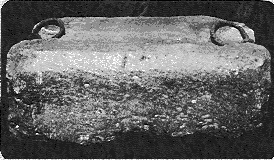
At Tara Zedekiah's daughter queen Teia Tephi married Eochaidh the High-king of Tara, who was descended from Pharez's twin brother Zarah of the "Red Hand" branch of the line of Judah (Genesis 38:28-30*), on the 21st June 583 B.C., thereby sealing the breach that was caused by the twins' birth, hundreds of years earlier. This marriage united the two royal lines of the primordial twins; Pharez and Zarah; that sprang from Jacob/Israel's fourth of his twelve sons, who was called Judah. That is why there is a "Red Hand" (Eochaidh/Zarah) mounted on the "Star of David" (Teia Tephi/Pharez) under a single royal crown on the Ulster flag and the knights descended from Judah/Zarah were called the "Red Branch Knights."
*Genesis 38:28 And it came to pass, when she travailed, that [the one] put out [his] hand: and the midwife took and bound upon his hand a scarlet thread, saying, This came out first.
38:29 And it came to pass, as he drew back his hand, that, behold, his brother came out: and she said, How hast thou broken forth? Why has thou made [this] breach against thee? Therefore his name was called Pharez (Breach).
38:30 And afterward came out his brother, that had the scarlet thread upon his hand: and his name was called Zarah (Scarlet).

Teia Tephi landed at Howth on 18th June 583 B.C., with the Lia Fail Stone, three days before marrying Eochaidh, but Jeremiah had sailed off into the night with his ships containing The Ark of The Covenant and is said, in the Legends of Ulster, to have landed at Carrickfergus before travelling to Tara in Royal Meath, after the Battle of Unna, fought at Slane.
Jeremiah died on the 21st of September in 581 B.C., after hiding The Ark of The Covenant in a secret tomb at Tara and he was buried in what is now called Cairn T, at Loughcrew, nr. Oldcastle, Co. Meath, as is confirmed by the hieroglyphics on the stones inside it and about which I have written an explanatory booklet, similar to this one.
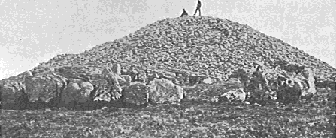
As a boy Eochaidh the High-king had been warned in a vision that he must not marry, even if he reached middle-age, until his queen came from the East. So when Teia came from Jerusalem, Eochaidh knew that this was the fulfillment of his vision. The couple fell in love, at first site, and were married three days later, at Tara, on the Inauguration Mound, where they gave their pledges over the Lia Fail Stone (the Stone of Destiny [above], that went from Ireland to Scotland in 500 A.D.; from Scotland to England in 1296 A.D. and then back to Scotland again in 1950. Nostradamus the sixteenth-century French prophet says it will return to Ireland very soon - please "CLICK HERE" for a detailed history of The Lia Fail Stone).
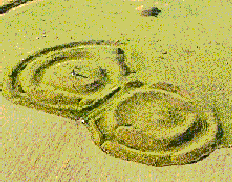
Teia and Eochaidh then abolished the unjust laws and taxes of the regional kings/warlords and instituted The Torah (God's Law) as the sole legislation for ALL of Ireland, which brought peace; prosperity and unity to the whole of Ireland for the very first time. However, this was not before many of the regional kings/warlords led by Bressail; who had been removed as regent because of his injustice; rebelled against Teia Tephi queen of Tara.
Teia Tephi was the War Queen of Ireland with the Olive Twig from Jerusalem and the Trident (taken from Neptune's Porch - Gibraltar, on her way to Ireland); who became immortalised in the form of the national emblem, Britannia.
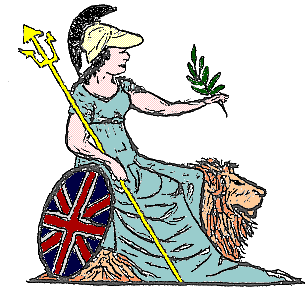
Nuadh of the Silver Hand, king of Ulster, who was a just king, sided with The Torah (God's Law); Teia Tephi; Eochaidh and Lughaidh* "Samildanach" against Bressail (who was later buried at Dowth, Co. Meath), leader of the rebel kings and Nuadh held a war-council at "Fair Emain", which is known today as Navan Fort.
* Levi.
Lughaidh "Samildanach" (man of all crafts) came with Teia Tephi to visit Nuadh's Court at Navan and played a joke on the guards at the entrance to the Palace. This joke has been passed down in Irish folk-lore and has survived the many centuries, intact, as Lughaidh prophesied and it is quoted below, from the "Book of Tephi Queen of Tara and Gibraltar":-
And the next day (we) drew unto Emain (Navan) riding thither full fast
Before our people, and Lughaidh swore that a jest TO LAST
Should be in our coming thither. So went he afoot to the hall,
His brightness veiled by a cloak. Now there stood two guardians tall
And haughty by Nuadh's threshold, and these men bade him to stay
Until his errand was told them. Then said he humbly, "I pray,
Doth Nuadh require a wheelwright?" and the porters answered him "Nay,
We have Luchta, the son of Lomhaid." Then asked he again, "I pray
Your favour, wants he a smith," and the porters again said "Nay,
Our smith is the thrice-skilled Colum." Then bolder he spoke, "I pray
Lack ye here for a champion?" and loudly the men cried "Nay,
Great Ogma cometh and Ethdan." Then sweetly he sung, "I pray,
Want ye my songs as a harper?" and proudly they answered "Nay,
For Ethan comes oft to our tables." So, solemn, he asked, "I pray,
Have ye preachers and pious amongst you," and scornful they spake him, "Ay,
The wisdom of Sri, the preaching of Mathgen." So laughed he, "I pray,
Are cupbearer's near to your lord?" They answered in mocking, "Ay,
Dathi leads twelve clad in crimson?" Then, formal, he questioned, "Pray,
Be there scribes or recorders with them?" Whereupon they answered him, "Ay,
Many scribes under En son of Eschmun." So, last he said, "I beseech
Your mercy in asking, hath Nuadh provided a skilful leech?"
One laughed and the other yawned. "The chief of that craft have we,
With son and daughter beside him, wellnigh as skilful as he."
Then Lughaidh cast cloak, and shouted, "Go, Kamal the son of Knees
And Hamal son of Formality, ask thy master, of these
Which man may do every service?" Right swiftly these lackeys sped
At his chiding, and Nuadh heard them, and came to the gate and led
The "man of all crafts"* to his table, where laughter and mirth was found
To greet us upon our coming, whilst gaily that jest went round.
* "Samildanach," a title of Lughaidh's who may have picked up his oriental terms of abuse (Gamul Mac Figol and Chamal Mac Rhiagild) in his wanderings, or learned them of the folk whom he is reported to have sent as far as the Persian court for steel weapons, probably unobtainable further West at that period - the sixth century B.C.
Teia Tephi also stated, in her "Book of Tephi Queen of Tara and Gibraltar", that the Gadite Israelite people of Gibraltar; referred to by Jeoffry Keating, in his "General History of Ireland", as Gadelians (the Eighth tribe of Israel - Gad was the eighth of Jacob/Israel's twelve sons); traded with the people of the "outer deep" in many things, including apes, and archaeologists have found the remains of a Barbary Ape, which is native to Gibraltar, at Navan Fort and have dated it to the Iron-Age, which is the period of Queen Teia Tephi.
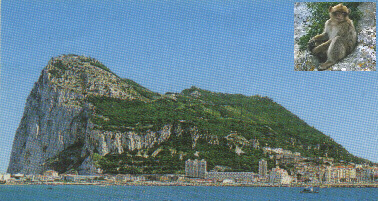
Nuadh king of Ulster fought for Teia Tephi, and to institute The Torah (God's Law) to Ireland, at the Battle of Unna (Destruction) where he bravely rode against Balor of the Mighty Blows (and Evil-eye) but was slain by Balor. After missing Balor with his first two spears Nuadh rode against him with his third spear but as he passed one of Balor's soldiers, the soldier struck his horse's heels causing it to rear-up and fall. Balor from the Western Isles leapt from his chariot and slew Nuadh with an iron craisech (a broad heavy spear with a blunt point).

There were 6,668 men killed at the Battle of Unna and they were buried in the Boyne Valley. Knowth was the tomb of the men of high rank, which is probably where Nuadh was buried; unless he was returned to Navan for burial; and its many satellite graves are where those of lesser rank were buried.
Perhaps in the near future archaeologists will find the silver hand of Nuadh in Knowth or perhaps here in "Fair Emain", Navan, the Ancient Capital of Ulster.
There is another Navan in Ireland in nearby Co. Meath which is where Nuadh used to stay when he went to the "Meetings of the kings" at the Rath of the Synods (Assemblies) on the Hill of Tara, known at that time as Cathair Crofinn.

It is even possible that, being closer to the Battle of Unna battle-site, Nuadh could have been buried at Navan, Co. Meath in the Domain of Teffia as she loved old Nuadh and would probably have liked to have him buried near to her.
In the "Book of Tephi Queen of Tara and Gibraltar" God prophesied that the people of Ireland would forget Teia and His Torah (Law) that brought peace and prosperity to Ireland and that, because of that, people would again make up their own laws and taxes and Ireland would become divided; the people become impoverished and the country war-torn, where "Brother slayeth his brother", until Teia Tephi is removed from her secret tomb in the Hill of Tara and shown to ALL of the people of Ireland, along with The Torah.
When this is completed and the people know their true history; identity and heritage and return to and keep The Eternal Covenant, that all of their fore-fathers made with God at Horeb in Sinai, binding on their children in perpetuity, God has promised to bring peace; prosperity and unity once again to Ireland. This will take the "ire" out of Ireland for ever and make it become Peaceland, and nothing else will, because He says so.
Knowth is the English name for Cnogba "Nut Lamentation".
Magh Macha has a wood, rich in nut-clusters, in the western part, where the all-pervading aroma of the nuts used to excite the animals. Emain Macha - Navan Fort was Nuadh's home. As Nuadh was the much loved brave and honourable king of Ulster who lived at Emain Macha - Navan; Knowth is probably Nuadh's Grave, where he was buried after he fell at the Battle of Unna (Destruction) opposing Bressail "Bodibal" mac Elatha and the people lamented his death. The tomb entrance-passage faces the entrance of Dowth so that Nuadh and Bressail would face and oppose each other forever. Around the tomb are many satellite graves which would be the graves of the soldiers of lesser rank that fell with Nuadh during the battle, whilst defending Teia Tephi, who was later wrongfully deified as the goddess Bovinda (Heifer), or Bo for short. The Battle of Destruction was fought nearby, at Slane.
Legend has it that Lughaidh "Lamhfhada" (long-hand) also known as "Crom Dubh" (the one bowed to the black haired heifer - Teia Tephi), the son of the great Ith Cian, the king of Spain, buried his wife at Knowth.
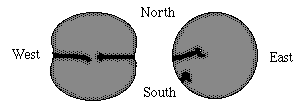
Dowth - Dubad "Darkness" is the tomb of Bressail "Bodibal" mac Elatha, the son of Elatha ruler of Cornwall in the sixth century B.C. Bres was a very handsome man, loved by the Irish women for his good looks but hated by the menfolk for his greed and meanness.
Bres lived in Ireland for some years and was made the champion and regent of Nuadh of the Silver Hand, king of Ulster, for seven years, during which time he hoarded wealth and made the menfolk's lives a misery. On receiving notice from Cornwall he went home to fetch and escort Teia Tephi, the mother of Aengus who built Newgrange, from Cornwall to Tara, years before Aengus was born.
At Tara, after Tephi was inaugurated as queen of all Ireland, the people complained to her about Bres, so she arranged an election in which he was removed as regent. His laws and taxes were then abolished and The Torah put in their place. At that point a number of kings and warlords in the already divided and war-torn country of Ireland joined Bres and rebelled against Tephi, because under The Real Law of The Torah, that she brought, they would have to give back all the wealth that they had un-fairly stolen from the people under their own laws and taxes that they had made up themselves. A huge battle then transpired, known as the Battle of Unna (Destruction), where all of the rebel kings and warlords and their armies led by Bressail the son of Elatha of Cornwall, fought against Teia Tephi and her army. As Teia Tephi was fighting for God and His Laws, her army defeated all of the rebels in the battle which was held at Slane, called the Battle of Unna (Destruction), which commenced on 31st October of 583 B.C. and lasted for four days.
On the 27th October of 583 B.C., four days before the battle commenced, there was a Lunar Eclipse in the Constellation of Taurus, when the Moon would have looked blood-red and would have been interpreted as an "Omen of Death" and defeat for the Baal-worshippers, whose symbol is the bull. Taurus being the sign of the bull. The Baal-worshippers led by Bressail mac Elatha (known in legend as Bressail "Bodibal" - "Bo destroyer") fought to destroy God's Chosen, Teia Tephi (Bo) at the Battle of Destruction, but failed. This Lunar Eclipse is shown in hieroglyphics in Jeremiah's Tomb, Cairn T at Loughcrew, nr. Oldcastle.
There was a total of six thousand six hundred and sixty-eight people killed in the Battle of Unna. Five thousand and sixty-three of whom were on Bressail's side including forty-two kings from various regions of Ireland, and the rest of the British Isles. From Teia Tephi's army, only sixteen hundred and five were killed, those of rank from both sides that fell at the battle were buried at Knowth and those of lower rank were buried in the many satellite graves around Knowth and through-out the Boyne Valley.
Bressail, the leader of the rebels, although defeated, wasn't killed in the battle and after swearing allegiance to Teia Tephi and The Torah was sent out to help clear the sea of Fomorians (pirates). The people never forgot his meanness and arrogance and when he died he was buried in the tomb that was made to face the setting sun rather than the sunrise and his tomb was named Dowth which is derived from the old Gaelic word, Dubad, meaning darkness. He had fought for the lord of Darkness against God the Lord of Light, attempting to defeat and destroy God's Chosen, Teia Tephi and God's Perfect Law - The Torah.
We hope you have enjoyed your visit to Navan Fort and that you will tell your family and friends and that we will see you again to wish you once again; as our cousins in the South say; Cead mile failte, which means, in English, a hundred thousand welcomes. JAHWhen travelling through and visiting the Heritage sites in beautiful Ulster and the Republic, PLEASE take only photographs and leave only footprints.
Thank you.
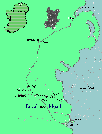
The autobiography of queen Teia Tephi, that she wrote at Teltown, is called the "Book of Tephi Queen of Tara and Gibraltar". It is absolutely full of ancient historical and prophetical information including prophecies about the near future. It is a fascinating book written in verse, like the famous Irish Metrical Dindsenchas, and costs only £10.
|
|
|
|
|
|
|
|
|
|
|
|
|
|
|
|
|
|